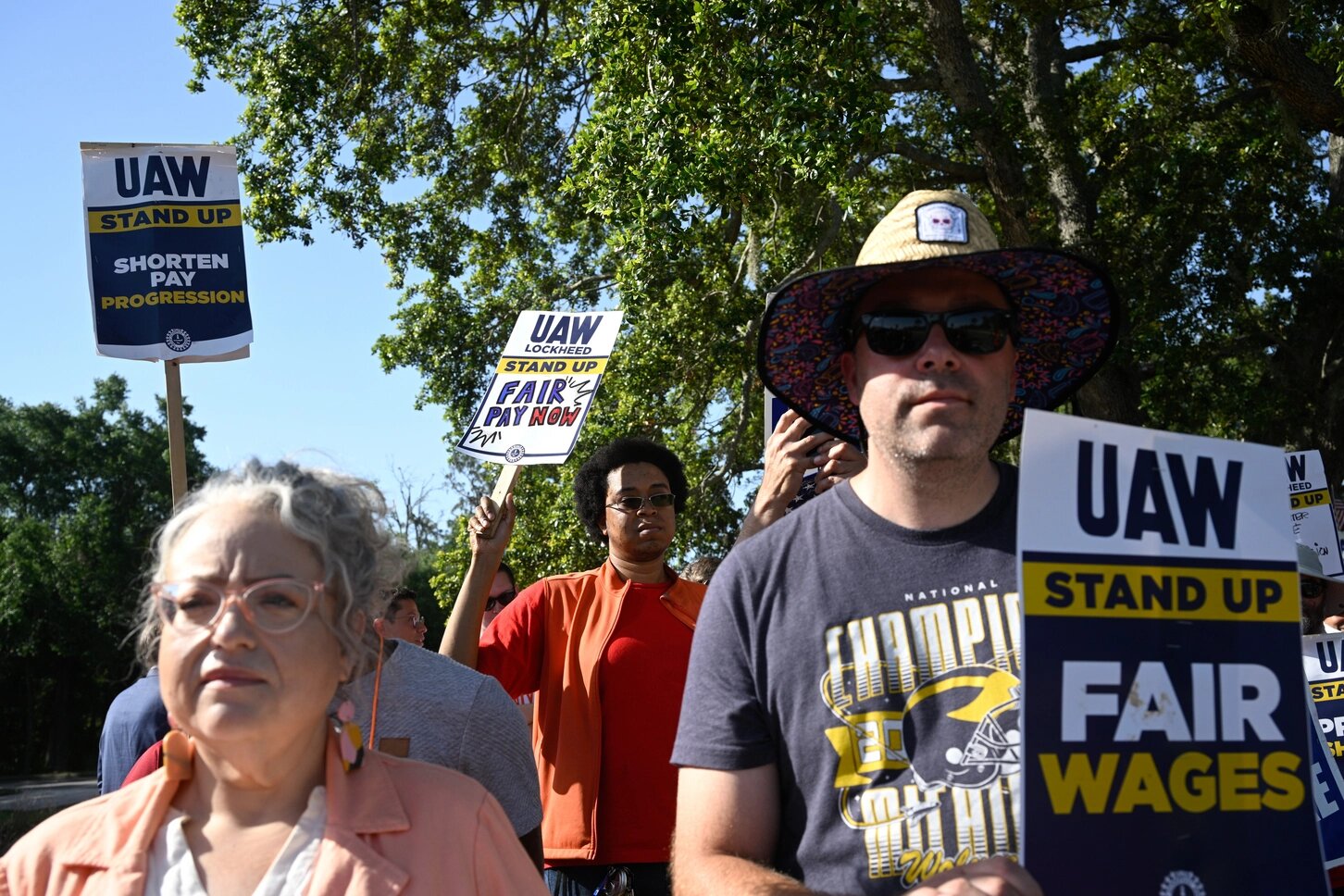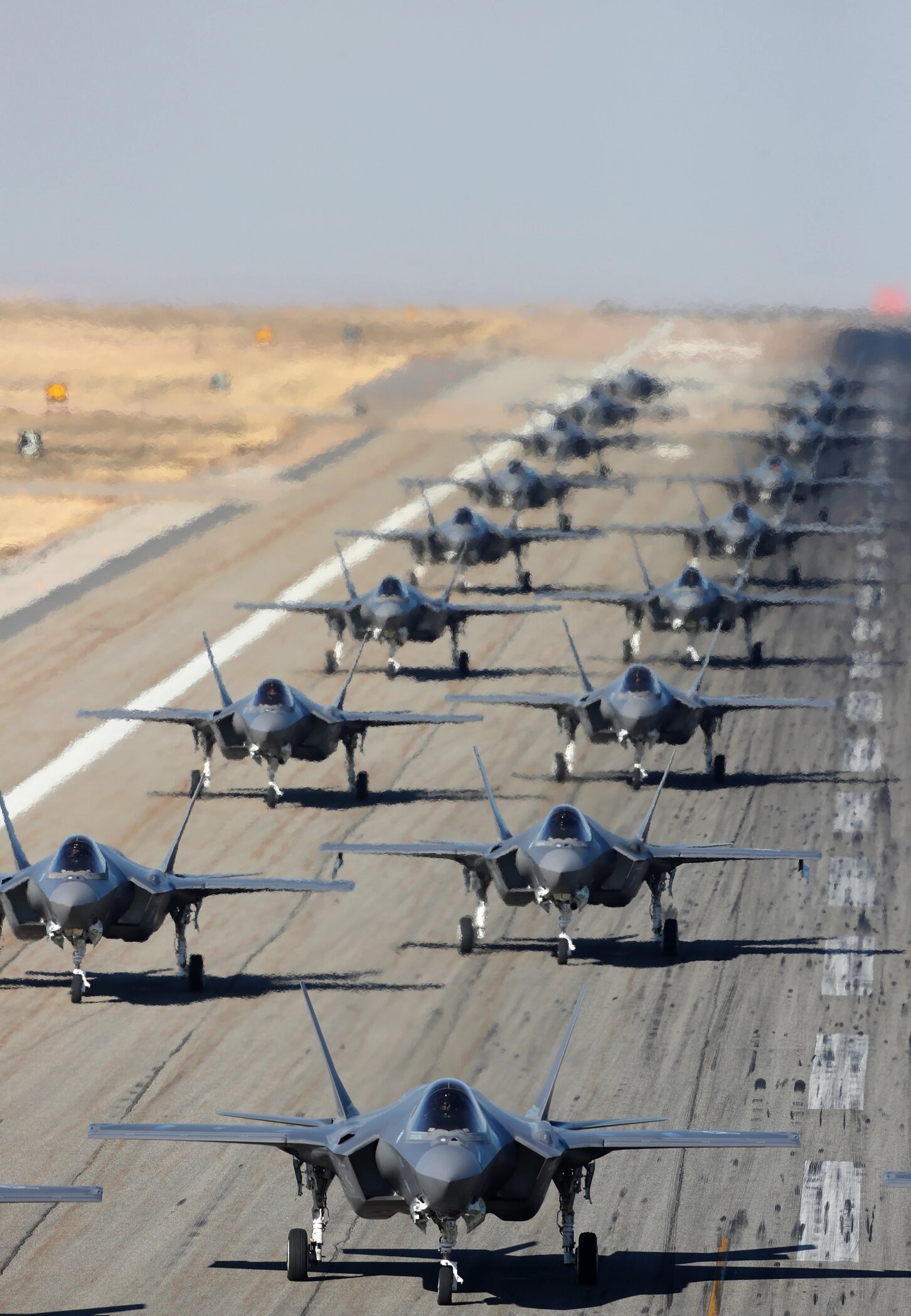This summer, employees at several big defense companies went on strike. Their grievances highlight a much larger problem brewing beneath the surface.

ORLANDO, Florida — On the Monday morning of Memorial Day, Randy Tejada arrived at a picket line outside Lockheed Martin’s enormous missile factory here, joining about 40 of his colleagues as they stood on a grassy median nearby, holding signs and waving at the passing cars. The missile factory, strangely, was nestled between Disney World and Universal Studios; a giant Ferris wheel loomed across the street from the picket line, creating an almost festive atmosphere. But Tejada had a serious look about him, like a soldier taking up watch duty. He wore a tee-shirt that said: “Grumpy Old Vet. I do what I want.” The air was sweltering, but Tejada said he wasn’t bothered.
“I can stay here as long as I need to,” he said. “I’ve got experience in standing around for hours.”
He was citing his past career in the military: Tejada is a 32-year-old retired U.S. Army helicopter mechanic who joined Lockheed Martin in 2022 on the assembly line. But this spring, after two years of going back and forth with management over problems with his pay, Tejada, along with several hundred of his Orlando colleagues, decided he’d had enough. Wages weren’t keeping pace with inflation; between late 2020 and mid-2022, for example, workers got a 3 percent pay bump as inflation rose by 12 percent. Their health care plans were expensive, the pensions enjoyed by older workers had vanished and the cost of rent in Orlando was skyrocketing. When Lockheed Martin offered the labor union a new contract this spring, the union asked for double-digit pay increases to cover higher costs. The company offered about 3 to 4 percent instead. On May 1, the employees walked off the job and went on strike. For nearly a month, they left empty the workstations where they once assembled missile components, surveillance systems and other defense equipment. The striking workers heard that Lockheed Martin was employing managers, engineers and contract workers to keep the factory going.

The Lockheed strike was part of a wave of labor unrest that swept America’s military-industrial complex over the past year. On May 1, about 4,000 workers went on strike. Nearly 1,000 of them worked for Lockheed Martin, both at Tejada’s facility in Orlando and at another complex in Denver. It was the first labor strike at the Orlando factory since 1963. Another 3,000 employees went on strike in Hartford, Conn., against Pratt & Whitney, which makes engines and other critical components of Lockheed Martin’s F-35 fighter jet. In mid-May, about 2,500 employees of General Dynamics nearly went on a strike at a nuclear submarine factory, before reaching a last-minute deal that kept them on the factory line. Last fall, 33,000 workers went on strike at Boeing, affecting production of both commercial and military aircraft and winning a 38 percent pay raise after seven weeks.
Something is going wrong on the assembly lines of America’s arsenal of democracy, and it’s happening at a moment of crisis. The White House, Pentagon and America’s overseas allies are all demanding that defense companies ramp up production to meet the needs of a dangerous geopolitical moment. America is running short of missiles, munitions and battleships. Allies are waiting years for deliveries. Even the Pentagon has to stand in line and wait for delayed shipments of major weapons, like Hellfire missiles, Javelin rocket launchers and sophisticated air defense interceptors. America is trying to surge its military capacity to produce more munitions, missiles and ships, but to do so, it must rely almost entirely on a group of five Fortune 500 defense companies. And none of these companies seem to be on war footing.
Instead of hiring more workers and paying workers more in an effort to retain them, these companies are far more focused on meeting the demands of Wall Street, trying to entice investors and boost their stock price by cutting costs, as well as using billions of dollars in revenue to pay handsome dividends and buy back shares of stock. Last year, for example, Lockheed Martin gave $6.8 billion in buybacks and dividends directly to its shareholders, which amounted to nearly 10 percent of the company’s total revenue and was larger than the $5.3 billion it kept in profits. The same year, RTX (formerly called Raytheon) paid $3.7 billion to shareholders, General Dynamics paid $3 billion and Northrop Grumman paid $3.7 billion. The billions of dollars they send back shareholders each year means that there is less money to go toward paying, hiring or retaining their employees.

As a result, jobs in defense manufacturing are becoming less and less attractive at a time when they need to be getting far more attractive. Many workers are leaving the field or declining to enter it. A survey by the job recruiting firm Acara found that annual turnover in the defense and aerospace industry hit 13 percent in 2023, compared to an average U.S. rate of 3.8 percent. And this is happening just as the need for those skills is rising. Demand for advanced manufacturing skills in the sector is outpacing the number of trained employees, and 75 percent of defense companies are struggling to find qualified employees, the survey found.
Take Tejada. He is exactly the kind of employee that the Pentagon desperately wants companies like Lockheed to hire. He’s experienced. He’s patriotic, with military experience. And he wants to build a career in the defense industry. His union in Orlando represents more of those kinds of workers. A lot of the employees in it attended a local community college industrial training center where they learned how to assemble complex circuit boards and to run ultra-high-precision machining tools. And many of them have worked at Lockheed Martin for years, if not decades, building the type of expertise that is currently in such high demand.
On the afternoon of May 1, those employees closed up their workstations, put away their tools and decamped to a grassy median along the west side of the Lockheed missile factory. They set up tents and folding chairs and unfurled large banners with inflammatory declarations about corporate greed and unfair labor practices. The several hundred members of UAW Local 788 launched a campaign that day that would, over the next few weeks, turn into a long and grinding campaign.
For the Pentagon, it should have also been a flashing red light — the latest in a long-simmering labor conflict that, from another angle, is also a growing national-security problem.
The landscape around the strikers was surreal in a particularly American way. Back when the missile factory was first opened in 1957, Orlando was a small town surrounded by cattle ranches and citrus groves. It has since transformed into the Mecca of American escapism. The missile factory is surrounded by Universal theme parks, Walt Disney World and a host of busy hotels and convention centers. On rainy nights along the picket line, the fireworks from Disney World could be heard crackling in the clouds while below, the UAW workers held their positions around the clock. They sat in chairs through the nights and waved their signs in the morning, determined to outlast Lockheed in a battle of attrition.
Historically, in the fight against their bosses, unions have had only one real weapon to wield: their numbers. The primary goal of a labor strike is to blockade production and inflict pain on the company so that it will negotiate better terms. But in Orlando, it was hard for the union to enlist enough workers for the fight. Florida is a “right to work” state, meaning that union membership is optional. Workers in an organized factory are free to return to their stations and get back to work, leaving everyone else on the picket line to fight for a contract that would eventually apply to everyone.
The burden of maintaining a successful picket line rested on the shoulders of hourly workers like Gideon Spence, a 37-year-old machinist at the missile factory who constructs finely honed components of weapons systems for the F-35 and Hellfire missiles. Spence is a burly guy with a thick red beard and bright blue eyes who is obsessively focused on his craft. He operates something called a Computer Numerical Control machine, or CNC for short, that shapes raw metal into precision weaponry, with a margin of error that is measured in the millionth of an inch. Spence is on the younger end of the Lockheed workforce, a member of the new generation of workers that military contractors are trying to attract and train. Lockheed Martin, like other contractors, has suffered a wave of retirements over the last decade as the skilled workforce it built up during the Cold War aged out into retirement, draining the best-trained and most experienced employees. This “experience drain” is a key concern for the Pentagon, which it has primarily addressed through education, such as with vocational programs at community colleges or other centers outside the defense companies themselves. But people like Spence are entering the field and quickly discovering that it’s very different from the one described by industry veterans at the union hall.
Unlike his elders, Spence doesn’t have a pension, he has to pay for more of his health insurance out of pocket, and his pay raises have fallen far behind the rising cost of rent, auto insurance and grocery bills. Spence lives about an hour away from the factory because he can’t afford a place in Orlando. Spence also belonged to a generation that often sees labor unions as a relic of the past. In the 1950s, labor unions represented about 30 percent of private-sector workers in the United States. When Spence joined Lockheed, they represented about 6 percent.
The weakness of the union made it a vulnerable target. On the first day of the strike, just hours after workers took up their picket signs, Lockheed Martin’s labor relations team launched a series of precision strikes that seemed aimed at breaking the union’s resolve. On the first day of the strike, union members received an email from Lockheed’s human resources department, sent to their personal accounts at 1:14 p.m. The email’s subject line read: “Procedure to Resign from the Union and Cross Picket Line.”
The text of the email laid out how anyone could file a letter of resignation from the union, notify their manager of the decision and be back on the job at full pay the next day. The email included carefully written statements pointing out that the H.R. team wasn’t recommending that anyone should do this, which might be a violation of labor law, but was simply explaining how to do it should anyone want to.
Lockheed Martin declined to comment in detail for this story. The company issued a statement in response to several detailed questions, pointing out that it engaged in good faith bargaining with the labor union throughout the strike. “These negotiations reflect our shared commitment to supporting the highly skilled workforce that drives our business and advances our national security mission,” the statement said.
On May 23, after three weeks of the strike, a spokesman for the Pentagon’s Missiles and Space Program Office said the Department of Defense had not yet seen an interruption in delivery for Hellfire and so-called JAGM Missiles, important munitions that are designed in Orlando, although full production is spread across several plants. Both missiles were currently on backorder with multi-year wait times, but it didn’t appear the strike would significantly extend those waits. He added: “We will continue to monitor very closely.”
The history of labor unions and the military-industrial complex can best be described as long and tortured.
There has always been an affinity between the two camps. One of the primary promises of an expanded defense industry is that it provides well-paying jobs around the country, a fact that companies like Lockheed Martin heavily promote. Since the 1950s, labor unions have seen the defense industry as a key lifeline to advanced manufacturing jobs, a trend that only accelerated after deindustrialization swept America starting in the 1970s. The weapons industry has now become one of the last vibrant islands of sophisticated manufacturing work in the United States.
Defense jobs account for about 10 percent of America’s manufacturing output, and the bulk of those jobs are high-end, advanced manufacturing that require a lot of skill and training. Lockheed Martin’s F-35 factory in Fort Worth, Texas, for example, contains a mini-factory within it where engineers and production experts build new robots to automate and streamline more parts of the assembly line. The assembly line itself is staffed by workers who painstakingly install expensive sensors and components into every tiny niche of the plane’s body.
But in important ways, the interests of unions and the defense industry have also always been at odds. Defense contractors and the Pentagon have an overarching interest in making weapons as cheaply as possible, which means keeping labor costs low.
These tensions intensified in the aftermath of the Cold War. In 1993, Secretary of Defense Les Aspin called a group of major defense industry CEOs to a dinner that became known as “the last supper.” The companies were encouraged to merge with one another to reduce their output in an age of shrinking military budgets after the Cold War. They did, consolidating control within five firms. Not even a full decade after those mergers came 9/11, after which military budgets exploded, but the same five firms dominate the market, receiving about one-third of all Pentagon contracts and contributing to about 74 percent of all major weapons systems, according to a 2024 report from the Congressional Research Service. Today, Lockheed is the biggest of all these contractors. It received $313 billion dollars of the $2.4 trillion that went to defense contractors over the past five years, more than twice as much as the next biggest company, RTX, according to a new report by the Quincy Institute for Responsible Statecraft and the Costs of War project at Brown University. Lockheed’s F-35 program is the single largest weapons program at the Department of Defense.
These defense companies had tremendous leverage when negotiating with the Pentagon during the War on Terror, according to Frank Kendall, who was the Air Force secretary from 2021 to 2025 and who previously served as head of acquisitions from 2011 to 2017. “With size comes power, and the Department’s experience with large defense contractors is that they are not hesitant to use power for corporate advantage,” Kendall wrote in a 2017 book on the acquisitions system. This meant that the companies would stubbornly bargain for months at a time for higher contract payments or better terms on project upgrades, for example, even when the Pentagon was eager and ready to move forward.
Kendall, while he criticized the companies, also reflected a widespread sentiment inside the Pentagon that the companies also had an imperative to earn profits in order to remain healthy: “Profit isn’t optional for businesses,” he wrote. The key was to make sure that the profit motive could be well-aligned with Pentagon priorities.
But the years after 9/11 would show how difficult it was to align these priorities. During the 2000s, the big defense contractors worked relentlessly to expand their profit margins, make their production lines as lean as possible and boost their annual sales. Raytheon’s stock price nearly quintupled from 2001 to 2021 while Northrop Grumman’s rose nearly 700 percent. Lockheed Martin did exceptionally well between 2001 and 2022, when the company’s stock price rose more than tenfold from $34.68 to $389.13 a share. The profitability came, in part, because Lockheed was focused on keeping labor costs low and supply lines trim.
In Orlando, the factory was running at high production during the War on Terror, said Billy Masters, a missile machinist who was the local union president until 2024. “We couldn’t make enough Hellfire missiles. As soon as we were shipping them, the paint was drying, and they were shooting them off,” Masters recalled during an interview in the local union hall in 2022. Employees felt like they were falling behind, especially in the later years of this long span, from about 2015 to 2022. Masters said in 2022 that many of his employees could barely afford apartments in the Orlando area, and one of his new hires was sleeping in her car. That year, an entry-level employee at the factory earned a minimum of $15.45 an hour, which was less than some service-sector jobs in the area. In 2025, a local Buc-ee’s gas station advertised wages for “restroom crews” starting at $20 an hour and car wash employees at $21 an hour.
A lot of people joined Lockheed because they thought it would provide a good long-term career path, but Masters said they found it difficult to live off the wages as they worked their way up the ladder.
“We cannot keep people!” Masters said. “They bring them in on the low end of the pay scale. … They want cheaper wages. They want to keep the wage down. We’re up against profit over anything else.”
This system delivered plenty of profits and munitions over 20 years of the War on Terror, but it seemed to hit a breaking point after Russian President Vladimir Putin invaded Ukraine in 2022. The following years of grinding trench warfare created a bottomless appetite for munitions that the United States was suddenly giving or selling by the thousands to its allies. America expended vast reserves of everything from Howitzer shells to advanced missile systems, first in Ukraine and then in Israel after the Hamas attack of 2023.
